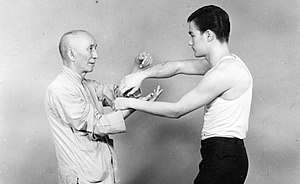Jeet Kune Do
Jeet Kune Do (Chinese: 截拳道; Cantonese Yale: jiht kyùhn douh; [tsìːt̚.kʰy̏ːn.tòu]), or "The way of the intercepting fist" in Cantonese, abbreviated JKD, is a hybrid philosophy of martial arts heavily influenced by the personal philosophy and experiences of martial artist Bruce Lee. Lee founded the system on July 9, 1967, referring to it as "non-classical", suggesting that it is a formless form of Chinese Kung Fu. Unlike more traditional martial arts, Jeet Kune Do is not fixed or patterned and is a philosophy with guiding ideas. Named for the Wing Chun concept of interception or attacking when one's opponent is about to attack, Jeet Kune Do's practitioners believe in minimal effort with maximum effect and extreme speed.
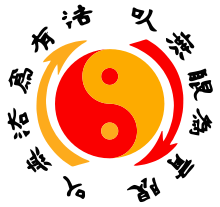 The Jeet Kune Do Emblem The Taijitu represents the concepts of yin and yang. The Chinese characters indicate: "Using no way as way" and "Having no limitation as limitation". The arrows represent the endless interaction between yang and yin.[1] | |
| Also known as | JKD, Jun Fan Jeet Kune Do, 截拳道 |
|---|---|
| Focus | Hybrid |
| Creator | Bruce Lee |
| Parenthood | Wing Chun, Hung Ga, Boxing, Kickboxing, Muay Thai, Escrima, Judo, Fencing, Tai Chi |
| Jeet Kune Do | |||||||||||||||
|---|---|---|---|---|---|---|---|---|---|---|---|---|---|---|---|
| Chinese | 截拳道 | ||||||||||||||
| Literal meaning | "Way of the Intercepting Fist" | ||||||||||||||
| |||||||||||||||
On January 10, 1996, the Bruce Lee Foundation decided to use the name Jun Fan Jeet Kune Do (振藩截拳道) to refer to the martial arts system which Lee founded; "Jun Fan" being Lee's Chinese given name.
It is referenced in the screenplay of the 1973 Warner Brothers film Enter the Dragon when Lee is asked, "What's your style?" and he replies, "My style?...You can call it the art of fighting without fighting."[2]
Background
Lee believed that kata forms and martial art tournament matches alike (like Karate) were simply "organised despair".[3] He believed that in order to "fully express oneself, one must" "have no limitations" (kata and rigid and non-flowing movements being the limitation). His system was new, and included all possible forms of strikes: attacks to the groin, finger jab to the eye as well as biting.
The name Jeet Kune Do was often said by Lee to be just a name, and he often referred to it as "the art of expressing the human body" in his writings and in interviews. Through his studies Lee came to believe that other styles had become too rigid and unrealistic. He called martial art competitions of the day "dry land swimming".[4] He believed real combat was spontaneous, and a martial artist cannot predict it, but only react to it, and a good martial artist should "be like water"—move fluidly without hesitation.
System and philosophy
Lee's philosophy
Originally, when Lee began researching various fighting styles, he called it Jun Fan Gung Fu. Not wanting to create another style which would share the limitations that all styles had, he instead described the process which he used to create it:
I have not invented a "new style," composite, modified or otherwise that is set within distinct form as apart from "this" method or "that" method. On the contrary, I hope to free my followers from clinging to styles, patterns, or molds. Remember that Jeet Kune Do is merely a name used, a mirror in which to see "ourselves". . . Jeet Kune Do is not an organized institution that one can be a member of. Either you understand or you don't, and that is that. There is no mystery about my style. My movements are simple, direct and non-classical. The extraordinary part of it lies in its simplicity. Every movement in Jeet Kune Do is being so of itself. There is nothing artificial about it. I always believe that the easy way is the right way. Jeet Kune Do is simply the direct expression of one's feelings with the minimum of movements and energy. The closer to the true way of Kung Fu, the less wastage of expression there is. Finally, a Jeet Kune Do man who says Jeet Kune Do is exclusively Jeet Kune Do is simply not with it. He is still hung up on his self-closing resistance, in this case anchored down to reactionary pattern, and naturally is still bound by another modified pattern and can move within its limits. He has not digested the simple fact that truth exists outside all molds; pattern and awareness is never exclusive. Again let me remind you Jeet Kune Do is just a name used, a boat to get one across, and once across it is to be discarded and not to be carried on one's back.
— Bruce Lee[5]
JKD as it has survived since—if one views it "refined" as a product, not a process—is what was left at the time of Lee's death. It is the result of the lifelong martial arts development process he went through. Lee stated his concept does not add more and more things on top of each other to form a system, but rather selects the best thereof. The metaphor Lee borrowed from Chan Buddhism was of constantly filling a cup with water, and then emptying it, used for describing Lee's philosophy of "casting off what is useless".[6] He used the sculptor's mentality of beginning with a lump of clay and removing the material which constituted the "unessentials"; the end result was what he considered to be the bare combat essentials, or JKD.[7] The dominant or strongest hand should lead because it would perform a greater percentage of the work. Lee minimized the use of other stances except when circumstances warranted such actions.[6]
Although the On-Guard position is a formidable overall stance, it is by no means the only one. Lee acknowledged there were times when other positions should be used. He felt the dynamic property of JKD was what enabled its practitioners to adapt to the constant changes and fluctuations of live combat. He believed these decisions should be made within the context of "real combat" and/or "all out sparring" and that it was only in this environment that a practitioner could actually deem a technique worthy of adoption.
Lee believed that real combat was alive and dynamic. Circumstances in a fight change from millisecond to millisecond. Thus, he believed, pre-arranged patterns and techniques are not even close to adequate in dealing with such a changing situation. As an antidote to this line of thought, Lee once wrote an epitaph which read: 'In memory of a once fluid man, crammed and distorted by the classical mess.' The "classical mess" in this instance was what Lee thought of the "not too alive way of the classical kung fu styles".[8]
Principles
The following are principles that Lee incorporated into Jeet Kune Do.[9] He felt them universal combat truths that were self-evident, and would lead to combat success if followed. Familiarity with each of the "four ranges of combat", in particular, is thought to be instrumental in becoming a "total" martial artist.
JKD believes the best defense is a strong offense, hence the principle of an "intercepting fist". For someone to attack another hand-to-hand, the attacker must approach the target. This provides an opportunity for the attacked person to "intercept" the attacking movement. The principle of interception may be applied to more than intercepting the actual physical attack; non-verbal cues (subtle movements of which opponent may be unaware) may also be perceived or "intercepted", and thus used to one's advantage. The "five ways of attack", categories which help JKD practitioners organize their fighting repertoire, comprise the offensive teachings of JKD. The concepts of "Stop hits & stop kicks," and "Simultaneous parrying & punching," based on the concept of single fluid motions which attack while defending (in systems such as épée fencing and Wing Chun), compose JKD's defensive teachings. These were modified for unarmed combat and implemented into the JKD framework by Lee to complement the principle of interception.
Stance
Seen in many of his movie fight scenes such as in the Way of the Dragon vs Chuck Norris, Bruce Lee fought in a side southpaw horse stance. His jabs and crosses came from his right hand and followed up with a lot of side kicks. Instead of a common check seen in muay thai, Bruce uses an oblique leg kick to block a potential kick. He adopted other defensive concepts found in many other systems such as slipping and rolling from Western boxing and forearm blocks found in Eastern martial arts such as Kung Fu.
Footwork
Lee's nimble and agile skipping-like footwork is seen in his movies. This technique was adopted from Muhammad Ali's footwork in his boxing stance. This footwork can be achieved from practice using a jump rope as jumping rope imitates this nimble, jumpy action that is a quick way to maneuvre your way around and away from an enemy's strikes. The footwork also has its influences from fencing.
Straight lead
Lee felt that the straight lead was the most integral part of Jeet Kune Do punching, saying, "The leading straight punch is the backbone of all punching in Jeet Kune Do."[10] The straight lead is not a power strike but a strike formulated for speed. It is believed that the straight lead should always be held loosely with a slight motion, as this adds to its speed and makes it more difficult to see and block. The strike is believed to be not only the fastest punch in JKD, but also the most accurate. The speed is attributed to the fact that the fist is held out slightly making it closer to the target and its accuracy is gained from the punch being thrown straight forward from one's centerline. The lead should be held and thrown loosely and easily, tightening only upon impact, adding to one's punch. The punch can be thrown from multiple angles and levels.[11]
Non-telegraphed punch
Lee believed that explosive attacks, without telegraphing signs of intent, were most effective. He argued that the attacks should catch the opponent off-guard, throwing them off balance and leaving them unable to defend against subsequent attacks. "The concept behind this is that when you initiate your punch without any forewarning, such as tensing your shoulders or moving your foot or body, the opponent will not have enough time to react," Lee wrote.[3] The key is that one must keep one's body and arms loose, weaving one's arms slightly and only becoming tense upon impact. Lee wanted no wind-up movements or "get ready poses" to prelude any JKD attacks. He explained that any twitches or slight movements before striking should be avoided as they will give the opponent signs or hints as to what is being planned and then they will be able to strike first while one is preparing an attack. Consequently, non-telegraphed movement is believed to be an essential part of Jeet Kune Do philosophy.[10]
"Be like water"
Lee emphasized that every situation, in fighting or in everyday life, is varied. To obtain victory, therefore, it is believed essential not to be rigid, but to be fluid and adaptable to any situation. Lee compared it to being like water, saying "Empty your mind, be formless, shapeless, like water. If you put water into a cup, it becomes the cup. You put water into a bottle and it becomes the bottle. You put it in a teapot it becomes the teapot. Now water can flow, or it can crash. Be water, my friend."[12] His theory behind this was that one must be able to function in any scenario one is thrown into and should react accordingly. One should know when to speed up or slow down, when to expand and when to contract, and when to remain flowing and when to crash. It is the awareness that both life and fighting can be shapeless and ever changing that allows one to be able to adapt to those changes instantaneously and bring forth the appropriate solution. Lee did not believe in styles and felt that every person and situation is different and not everyone fits into a mold; one must remain flexible in order to obtain new knowledge and victory in both life and combat. It is believed that one must never become stagnant in the mind or method, always evolving and moving towards improving oneself.[13]
Economy of motion
Jeet Kune Do seeks to be economical in time and movement, teaching that the simplest things work best, as in Wing Chun. Economy of motion is the principle by which JKD practitioners achieve:
- Efficiency: An attack which reaches its target in the least amount of time, with maximum force
- Directness: Doing what comes naturally in a disciplined way
- Simplicity: Thinking in an uncomplicated manner; without ornamentation
This is meant to help a practitioner conserve both energy and time, two crucial components in a physical confrontation. Maximized force seeks to end the battle quickly due to the amount of damage inflicted upon the opponent. Rapidity aims to reach the target before the opponent can react, which is half-beat faster timing, as taught in Wing Chun and Western boxing.[14] Learned techniques are utilized in JKD to apply these principles to a variety of situations.
Stop hits
"When the distance is wide, the attacking opponent requires some sort of preparation. Therefore, attack him on his preparation of attack. To reach me, you must move to me. Your attack offers me an opportunity to intercept you."[15] This means intercepting an opponent's attack with an attack of one's own instead of simply blocking it. It is for this concept Jeet Kune Do is named. JKD practitioners believe that this is the most difficult defensive skill to develop. This strategy is a feature of some traditional Chinese martial arts as Wing Chun, as well as an essential component of European épée Fencing. Stop hits and kicks utilize the principle of economy of motion by combining attack and defense into one movement, thus minimizing the "time" element.[16]
Simultaneous parrying and punching
When confronting an incoming attack, the attack is parried or deflected, and a counterattack is delivered simultaneously. This is not as advanced as a stop hit but more effective than blocking and counterattacking in sequence. Practiced in some Chinese martial arts such as Wing Chun, it is also known in Krav Maga as "bursting". Simultaneous parrying and punching utilizes the principle of economy of motion by combining attack and defense into one movement, thus minimizing the "time" element and maximising the "energy" element. Efficiency is gained by utilizing a parry rather than a block. By definition a "block" stops an attack, whereas a parry merely re-directs it. Redirection has two advantages, it requires less energy to execute and utilizes an opponent's energy against him by creating an imbalance. Efficiency is gained in that an opponent has less time to react to an incoming attack, since he is still withdrawing from his attack.
Low kicks
JKD practitioners believe they should direct their kicks, as in Wing Chun, to their opponent's shins, knees, thighs, and midsection.[17] These targets are the closest to the feet, provide more stability and are more difficult to defend against. Maintaining low kicks utilizes the principle of economy of motion by reducing the distance a kick must travel, thus minimizing the "time" element. However, as with all other JKD principles nothing is set in stone. In typical JKD style, if a target of opportunity presents itself, even a target above the waist, one could take advantage and not be hampered by this principle.
Three ranges of combat
- Long
- Medium
- Close
Jeet Kune Do students train in each of the aforementioned ranges equally. According to Lee, this range of training serves to differentiate JKD from other martial arts. He stated that most but not all traditional martial arts systems specialize in training at one or two ranges. His theories have been especially influential and substantiated in the field of mixed martial arts, as the MMA Phases of Combat are essentially the same concept as the JKD combat ranges.
As a historic note, the ranges in JKD have evolved over time. Initially the ranges were categorized as short or close, medium, and long range.[18] These terms proved ambiguous and eventually evolved into their more descriptive forms,[19] although some may still prefer these original three categories.
Five ways of attack
JKD's original five ways of attack are:
- Simple Angular Attack or Simple Direct Attack (SDA or SAA)
- Attack By Combination (ABC)
- Progressive Indirect Attack (PIA)
- Immobilization Attacks (IA)
- Attack By Drawing (ABD)
Centerline
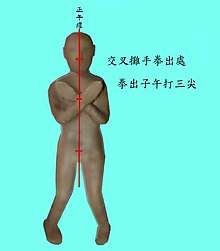
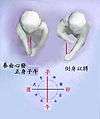

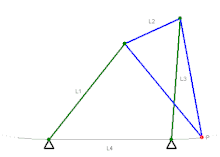
The centerline is an imaginary line drawn vertically along the center of a standing human body, and refers to the space directly in front of that body. If one draws an isosceles triangle on the floor, for which one's body forms the base, and one's arms form the equal legs of the triangle, then h (the height of the triangle) is the centerline. The Wing Chun concept is to exploit, control and dominate an opponent's centerline. All attacks, defenses, and footwork are designed to guard one's own centerline while entering the opponent's centerline space. Lee incorporated this theory into JKD from his Sifu Ip Man's Wing Chun.[20]
The three guidelines for the centerline are:
- The one who controls the centerline will control the fight.
- Protect and maintain your own centerline while you control and exploit your opponent's.
- Control the centerline by occupying it.
This notion is closely related to maintaining control of the center squares in the strategic game chess. The concept is naturally present in xiangqi (Chinese chess), where an "X" is drawn on the game board, in front of both players' general and advisors.[20]
Combat realism
One of the premises that Lee incorporated in Jeet Kune Do was "combat realism."[21] He insisted that martial arts techniques should be incorporated based upon their effectiveness in real combat situations. This would differentiate it from other systems where there was an emphasis on "flowery technique", as Lee would put it.[22] He claimed that flashy "flowery techniques" would arguably "look good" but were often not practical or would prove ineffective in street survival and self-defense situations. This premise would differentiate JKD from other "sport"-oriented martial arts systems that were geared towards "tournament" or "point systems" (traditional martial art). Lee felt that these systems were "artificial" and fooled their practitioners into a false sense of true martial skill. He felt that because these systems incorporated too many rule sets that would ultimately handicap a practitioner in self-defense situations and that these approaches to martial arts became a "game of tag" leading to bad habits such as pulling punches and other attacks; this would again lead to negative consequences in real world situations.[23]
Another aspect of realistic martial arts training fundamental to JKD is what Lee referred to as "Aliveness". This is the concept of training techniques with an unwilling assistant who offers resistance. He made a reference to this concept in his famous quote "Boards don't hit back!"[24] Because of this perspective of realism and aliveness, Lee utilized safety gear from various other contact sports to allow him to spar with opponents "full out". This approach to training allowed practitioners to come as close as possible to real combat situations with a high degree of safety.[25]
Conditioning
To keep up with the demand of Jeet Kune Do combat, the practitioner must condition his body. Some exercises Lee did included Da Sam Sing or Gak Sam Sing which is a traditional method of forearm conditioning practised in Classical Kung Fu. He also did exercises simulating a fight against a four-limbed human using the traditional Mook Yan Jong (Cantonese) used in Wing Chun.[26]
Bruce Lee was an avid follower of wrestler Great Gama's training routine. He read articles about him and how he employed his exercises to build his legendary strength for wrestling, quickly incorporating them into his own routine. The training routines Lee used included "the cat stretch", "the squat" (known as "baithak"), and also known as the "deep-knee bend."[27]
Influence and references in popular culture
Many characters in action films, videogames and anime use Jeet Kune Do as their personal fighting style, including: Kato (Bruce Lee) from The Green Hornet is the first fictional fighter to use Jeet Kune Do. Kareem Abdul-Jabbar a student of Lee used JKD against Lee in Game of Death. Lee chose Jabbar for this role to emphasize their difference in body size and displaying two fighters who had transcended "style". Jason David Frank, who plays Tommy Oliver in Power Rangers studied Jeet Kune Do in real life, bringing the techniques to the character. Shang-Chi from Marvel Comics. Sublime (Wildstorm) from Wildstorm Comics. A member of the DV8 team and a Jeet Kune Do practitioner. She is also a master of the three sectional staff. Seta Noriyasu, Naru Narusegawa, and Serah McDougal from Love Hina with the first teaching it to the others. Snake Eyes from G.I. Joe: A Real American Hero Sera Masumi from Detective Conan/Case Closed is a high school detective who is an expert in Jeet Kune Do. Liu Kang, Johnny Cage and Mokap uses JKD as a fighting style in Mortal Kombat. Jacky Bryant from Virtua Fighter. Marshall Law and Forrest Law from Tekken. Spike Spiegel from Cowboy Bebop. Midknight from Eternal Champions. Jann Lee from Dead or Alive Kamen Rider Meteor from Kamen Rider Fourze uses The Seishin Darinken (星心大輪拳 Seishin Dairinken, lit. "Star-Mind Large-Ring Fist"), a unique fictional style of Jeet Kune Do that can be incorporated with weapons, such as bo staffs and firearms.
References
- Bruce Lee: Dynamic Becoming, p.23
- Bruce Lee (1973). Enter the Dragon (Motion Picture). Event occurs at .
- Lee, Bruce (1975). The Tao of Jeet Kune Do. Ohara Publications. p. 14. ISBN 0897502027.
- "Jeet Kune Do | Southeast JKD". Southeast Jeet Kune Do. 22 April 2016. Archived from the original on 21 June 2019. Retrieved 21 June 2019.
- Lee, Bruce (September 1971), "Liberate Yourself From Classical Karate", Black Belt Magazine, Rainbow Publications, Inc., vol. 9 no. 9, p. 24.
- Warrior, J. K. D. (9 August 2018). "Modern Jeet Kune Do philosophy". Jeet Kune Do Combatives - JKD Philippines. Archived from the original on 2 June 2019. Retrieved 2 June 2019.
- Pollard, Maxwell (November 1967). In Kato’s Gung-fu Action is Instant. Black belt magazine. pp. 14–20.
- "Letters of Note: In Memory of a Once Fluid Man". 25 April 2011. Archived from the original on 31 July 2016. Retrieved 22 June 2016.
- Hochheim, W. Hoch (January 1995), "The Maze of Jeet Kune Do", Black Belt Magazine, Rainbow Publications, vol. 33 no. 1, p. 110
- Lee, Bruce (2011). Tao of Jeet Kune Do. Valencia: Black Belt.
- Lee, Bruce (2008). Bruce Lee's Fighting Method. Valencia: Black Belt.
- Lee, Bruce (1966). Pierre Barton Show. Hong Kong: Pierre Barton.
- Little, John (1973). Bruce Lee: In His Own Words (DVD). Warner Brothers.
- Chu, Robert (September 1991). "The Wing Chun Mind: Learn to Think Like a True Fighter". hawkinscheung.com. Inside Kung Fu. Archived from the original on 16 February 2013.
- "The Way of the Intercepting Fist". Longstreet. 16 September 1971.
- Cheng, David (15 July 2004). Jeet Kune Do Basics. Tuttle Publishing. p. 146. ISBN 978-0-8048-3542-8.
- "Jeet Kune Do Concepts". admakarate.com. Archived from the original on 10 August 2013. Retrieved 22 June 2016.
- Lee, Linda (1975), The Tao of Jeet Kune Do, Ohara Publications Inc., ISBN 0-89750-048-2
- "Fighting Ranges of Jeet Kune Do, Part 1". 9 December 2013. Archived from the original on 14 January 2020. Retrieved 24 November 2018.
- Argyridis, Panayiotis (12 October 2010). The Principles Theories and Practice of Jun Fan Gung Fu/Jeet Kune Do Vol.1. Xlibris Corporation. pp. 120–122. ISBN 978-1-4535-0635-6.
- Weiss, Adam. "philosophy of Jeet kune do". www.martialartssparring.org. Retrieved 21 June 2019.
- Stone, Zofia (1 March 2017). Bruce Lee: A Biography. Vij Books India Pvt Ltd. ISBN 9789386367280.
- David; Lumsden, Kevin (23 June 2010). The Iron Dragon: Richard Bustillo. Xlibris Corporation. p. 193. ISBN 978-1-4535-1025-4.
- "Bruce Lee Quotes". Archived from the original on 10 December 2011. Retrieved 25 February 2012.
- Weiss, Adam. "Bruce Lee Sparring Tips". www.martialartssparring.org. Retrieved 25 November 2018.
- "Training | Fundamentals | Canadian Hung Kuen Association | Regina Saskatchewan". www.fuhok.com. Retrieved 25 November 2018.
- Little, John, Bruce Lee – The Art of Expressing The Human Body (Tuttle Publishing, 1998), p. 58
Bibliography
- Assli, Salem (2002). Jeet Kune Do 'Toutes les techniques de Bruce Lee'. Editions Chiron. ISBN 2-7027-0693-2.
- Balicki, Ron; Steve Gold (2001), Jeet Kune Do: The Principles of a Complete Fighter, HNL Publishing, ISBN 0-9531766-3-0
- Beasley, Jerry (2001), The Jeet Kune Do Experience: Understanding Bruce Lee's Ultimate Martial Art, Paladin Press, ISBN 978-1-58160-131-2
- Bishop, James (2004), Bruce Lee: Dynamic Becoming, Dallas: Promethean Press, ISBN 0-9734054-0-6
- Cheng, David (2004), Jeet Kune Do Basics, Tuttle Publishing, ISBN 0-8048-3542-X
- Davis, Lamar (2001), Jun Fan/Jeet Kune Do: Scientific Streetfighting, HNL Publishing, ISBN 978-0-9531766-1-8
- Heath, Adam (2011), Mixed Martial Arts' Most Wanted: The Top 10 Book of Crazy Combat, Great Grappling, and Sick Submissions, Potomac Books Inc., ISBN 978-1597975490
- Hochheim, W. Hoch (January 1995), "The Maze of Jeet Kune Do", Black Belt Magazine, Rainbow Publications, Inc., vol. vol. 33 no. issue 1
- Kent, Tackett, Chris, Tim (1989), Jun Fan Jeet Kune Do: The Textbook, Action Pursuit Group, ISBN 0-86568-131-7
- Lee, Bruce (1975), Tao of Jeet Kune Do, Ohara Publications, ISBN 978-0-89750-048-7
- Lee, Bruce (1978), Bruce Lee's Fighting Method, Ohara Publications, Inc., ISBN 0-89750-062-8
- Little, John (1996), The Warrior Within: The Philosophies of Bruce Lee to Better Understand the World Around You and Achieve a Rewarding Life, McGraw-Hill, ISBN 0-8092-3194-8
- Little, John (1997), Jeet Kune Do: Bruce Lee's Commentaries on the Martial Way, Tuttle Publishing, ISBN 0-8048-3132-7
- Little, John (2001), Bruce Lee: Artist of Life, Tuttle Publishing, ISBN 0-8048-3263-3
- Little, John (2002), Striking Thoughts: Bruce Lee's Wisdom for Daily Living, Tuttle Publishing, ISBN 0-8048-3471-7
- Seaman, Kevin (1999), Jun Fan Gung Fu Seeking The Path of Jeet Kune Do, S.l.: Health 'N' Life, ISBN 0-9531766-2-2
- Thomas, Bruce (1994), Bruce Lee: Fighting Spirit, Berkeley, California: Frog, Ltd., ISBN 1-883319-25-0
- Yılmaz, Yüksel (2000), Dövüş Sanatlarının Temel İlkeleri, İstanbul, Turkey: Beyaz Yayınları, ISBN 975-8261-87-8
- Yılmaz, Yüksel (2008), Jeet Kune Do'nun Felsefesi, İstanbul, Turkey: Yalın Yayıncılık, ISBN 978-9944-313-67-4
